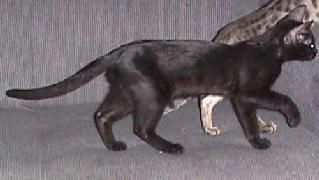Bengal Colors And Patterns
Colors - Included is a brief history of each color
Patterns - Included is a brief history of each pattern
Colors
Traditional Brown Tabby (also known as the Leopard color amongst breeders)
Browns can vary as to the intensity of the contrast and overall color but typically it is a golden brown with darker brown to black markings, and the tail tip must be black. Eye color tends to be green or gold.
History of the Brown Spotted Color
This is the "original" color of the bengal. All early bengals were brown's, mostly spotted. It wasn't until later inbreeding and linecrossing that the recessive color's and patterns showed up.
Makaila is a good example of a Brown Tabby.
Seal Lynx Point Tabby (also known as the Blue Eyed Snow amongst breeders)
Lynx points are an ivory to white color with gray to black markings, the more contrast the better, and they have striking blue eyes.
History of the Seal Lynx Point Color
This color started to turn up in the early breeding. It is believed that one of the early cats carried the lynx point gene (possibly Finally Found, a domestic shorthair used by Jean Mill). When these early cats were inbreed and linebred there were a few cases of these "white" kittens (Millwood Rapsody was the first lynx point kitten breed). Originally these kittens were altered and never breed because it did not resemble what early breeders had in mind. But through the workings of several breeders it is now a recognized (but still somewhat controversial) color.
Icy is a good example of a Seal Lynx Point.
Seal Mink/Seal Sepia Tabby (also known as the Green Eyed Snow amongst breeders)
These two colors are hard to distinguish at times and are similar in looks but not in genetics. Minks and sepias have the ivory background and tend to have much better contrast and much darker markings then lynx points (sepias much more so then minks) and they have aqua to green eyes (sepias will have green to gold eyes). Sepia's and Mink's are very hard to tell apart, the only accurate way to tell is through breeding. In order for a bengal to be a mink it MUST have at least one Burmese ancestor. In order for a bengal to be a sepia it MUST have at least two Burmese ancestors, one from each of its parents.
History of the Seal Mink/Sepia Color
The mink and sepia color was created when a brown spotted tabby (Gogees Warhawk), that carried lynx point was breed to a Sable Burmese (Little Booger). It was an experiment between two breeders in trying to get a non-color point bengal. One of the most notable bengals from the first breeding was Bo Dazous the mother of Nola Kotton Picking (considered by many to be the foundation sire of the mink/sepia color).
Shadoo is a good example of a Seal Mink.
Fad is a good example of a Seal Sepia.
Unrecognized Colors
Silver - Silver comes from the Mau influence. It is a dominant gene and a good silver should have no ruffosing in their background (called tarnishing). Silver is very hard to work with if you are not experienced in it.
Sterling is a silver bengal
Melanistic - The solid bengals do resemble mini-black leopards, but they are not the best to use in a breeding program. I hear many say they will clear up ticking, in my experience they actually increase the ticking. Not to mention most black's are very hard to see their patterning. The solid gene comes from the Mau and Burmese influence.
Magic is a black bengal
Blue - Blue is the dilution of black. These cats tend to have a grayish colored pattern with a light to apricot colored undercoat. Blue's come from Ocicat influence as well as the early foundation cats appeared to carry it.
Chocolate - A light brown color, often seen best on the tail tip, paw pads will have a rosy undertone. Chocolate can come from the Abby background or the Ocicat background.
Cinnamon - Much lighter then chocolate and a light reddish hint to it normally. Cinnamon comes from the Abby background.
Patterns
Spotted
Spots should be random or horizontally aligned, with little to no vertical baring or alignment. Rosettes are preferred to solid spots but not required. Cats with larger spots tend to look more wild then smaller spotted cats.
History of the Spotted Pattern
This is the "original" pattern, nearly all of the early bengals are spotted to some extent. But once again when the inbreeding and linebreeding was done the recessive marble pattern started to turn up.
Amber is a good example of a Spotted Bengal
Marbled
Marbled Bengals should have swirling streaks of color running horizontally will little to no vertical alignment. The pattern should not resemble the classic tabby "bullseye". Tri-colored pattern is preferred over solid pattern, and they should have a spotted belly.
History of the Marbled Pattern
This is another recessive that was carried by one of the early bengals. Many of the first marbled bengals had very domestic patterns but through selective breeding and the influence of the ALC's horizontal pattern the marbles have evolved into the striking cats you see now. Millwood Painted Desert was the first marble produced who then went on to produce several well seen cats such as Snowbear Cloud Nine of Millwood (where many of Millwood's rosetted cats come from).
Anna is a good example of a Marbled Bengal
Track on Back to EmberGlo's Main Page


